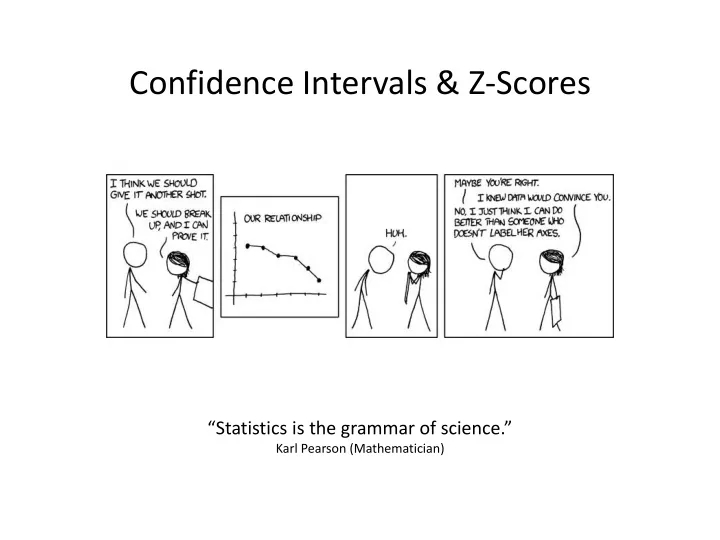

Confidence Intervals & Z-Scores “Statistics is the grammar of science.” Karl Pearson (Mathematician)
Standard error “How confident are we in our statistic?” Standard error – standard deviation of a statistic Standard error of the mean - reflects the overall distribution of the means you would get from repeatedly resampling 𝑇𝐹 𝑦 = 𝑡 s = sample standard deviation 𝑜 n = sample size Small values = the more representative the sample will be of the overall population Large values = the less likely the sample adequately represents the overall population
The t-distribution (a.k.a The Student t-distribution) • Has fatter tails then the normal distribution • Degrees of freedom: 𝑒𝑔 = 𝑜 − 1 • As sample size increases – it approaches the normal distribution • Properties: William Sealy Gosset (1876-1937) Bell-shaped mean=median=mode=0 Variance > 1 Normal distribution t-distribution (sampling distribution)
Confidence Intervals 𝑇𝐹 𝑦 = 𝑡 Based on this curve: 𝑜 • 68.27% confident that the true mean is within 1 𝑇𝐹 𝑦 of 𝑦 • 95.45% confident that the true mean is within 2 𝑇𝐹 𝑦 of 𝑦 • 99.73% confident that the true mean is within 3 𝑇𝐹 𝑦 of 𝑦 For confidence intervals: 𝐷𝐽 95 = 𝑦 ± 𝑇𝐹 𝑦 ∗ 1.96 • 95% confident that the true mean is within 1.96 𝑇𝐹 𝑦 of 𝑦
Standard deviation vs Standard error “What should I display as part of my results?” “What message do I want to give?” 68% of raw 68% confident data falls that the true within here mean is in here 𝑜 𝑦 𝑗 − 𝑦 2 𝑡 2 = 𝑇𝐹 𝑦 = 𝑡 Standard Deviation Standard Error 𝑗=1 𝑜 𝑜 − 1 (descriptive statistics) (inferential statistics) “trying to describe data” 𝑡 2 “trying to draw conclusions” s = 𝐷𝐽 68 = 𝑦 ± 𝑇𝐹 𝑦
More Vocabulary • Percentile – the value below which a given percentage of observations within a group fall • Quartile – (1 st , 2 nd , 3 rd , 4 th ) points that divide the data set into 4 equal groups, each group comprising a quarter of the data • Alpha level – predetermined probability where we make some sort of decision • P-value – (percentiles) the probability the observed value or larger is due to random chance • Critical t-value – the t-value that corresponds to the 𝛽 − 𝑚𝑓𝑤𝑓𝑚 • Actual t-value – the t-value that corresponds to and raw data value being tested with the 𝛽 − 𝑚𝑓𝑤𝑓𝑚 (signal-to-noise ratio) • Signal – the difference between the test and mean values • Noise – measure of the distribution of the data
How to convert between scales Raw data value Original units 𝑦 (𝑤𝑏𝑚𝑣𝑓 − 𝑦 )/𝑇𝐹 𝑦 ( t- 𝑤𝑏𝑚𝑣𝑓 ∗ 𝑇𝐹 𝑦 ) + 𝑦 Critical t-value T-value (standard error) -3 -2 -1 0 1 2 3 𝑟𝑢(𝛽, 𝑒𝑔) p 𝑢( t− 𝑤𝑏𝑚𝑣𝑓, 𝑒𝑔) -level P-value (percentiles, 0.999 0.001 0.50 probabilities)
Z-scores • Similar to the t- distribution for large sample sizes (N≥30) • Need to know the population standard deviation is known • Why we use the t-distribution for statistics • But we can use it to define where a given value falls within a distribution of values in terms of standard deviations away from the mean Raw data value Original units 𝑦 (𝑤𝑏𝑚𝑣𝑓 − 𝑦 )/ s ( z- 𝑤𝑏𝑚𝑣𝑓 ∗ 𝑡) + 𝑦 Z -value Z-score (standard deviation) -3 -2 -1 0 1 2 3
Recommend
More recommend